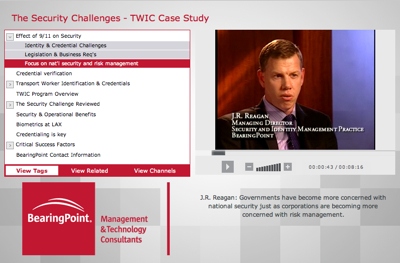Veotag demonstrates video value

The last six months has seen an explosion in the number of video startups looking to make their name. Most are in the consumer space with little idea of how to monetize. Veotag, which was founded in 2006, is different. I first came across the company about a year ago when they introduced a consumer style application that allows the user to create podcast and vidcasts that can be time sliced. At the time, I saw the value but couldn't see the real world use case for this style of application. A year on and all is coming clear.
While video is a superb medium, it requires an investment in time that few knowledge workers have. If I am viewing say a keynote, the chances are that I'll only be interested in a handful of snippets. I certainly don't want to waste spending say 30 minutes out of a 45 minute show waiting to pick up the things that are of interest to me. This is where Veotag fits in. The Veotag platform allows content producers to time slice content and display that in a panel. The illustration I've used from a recent Bearing Point collection shows how this works. I can decide which slice of a particular video or podcast is of interest to me and select accordingly.
Last December, Veotag undertook a project on behalf of Ernst and Young related to a hedge fund conference. They took all the recorded material, repurposed it and tagged it within two days of the end of the event. Selected customers were then emailed with details which included links to the content most likely to be of interest to them. This speed of turnaround helps content reach a wide audience before it becomes 'stale.' All content is searchable which means that users can readily find the piece they wish to see along with related material. Other offered services include hosting, streaming, authoring, search engine optimization, player customization, player embedding, coordinated slides and analytics.
I spoke with co-founder Jeff Paul about the potential for other market beyond 'big media' and information worker requirements. He pointed me to JoVE which is a video collection destination for biological research. Jeff explained that in medical research, it is important not only document protocols but also demonstrate how they work in the real world. The JoVE site is an example of a turnkey site that exploits video to illustrate a variety of protocols that researchers choose to share.
Like many new services, there is a 'try before you buy' option but I was intrigued by Veotag's pricing model. The company offers two styles of licensing:
- e-learning and internal messaging where the system is likely to be deployed behind the firewall and
- an external model for those that wish to share their content publicly.
In the first model, price is per seat while in the public model it is based on page views. I asked why annual support and maintenance for the internal model is 20 per cent of the perpetual license figure. Jay said that unlike other types of business application, Veotag isn't selling modules but a complete content platform. Given the functional richness, options, the ability to integrate to other business processes and the fact customers can self brand, this represents good value for money.
The video market is wide open and provides plenty of opportunity for creative people to develop great content that adds business value. While it is still in its infancy - Veotag has around 40 corporate paying customers - the company is demonstrating a remarkable array of use case examples. I can for instance imagine how the traditional white paper might be supplemented or even replaced with video and/or podcast material, tagged and distributed as part of a rich media offering.
As part of its drive to encourage new customers, Veotag has set up what it calls the Veotag Challenge. This is a free service where the company will create an own branded channel for customers to try out the service over a limited period. That will help potential customers visualize how the service might look inside a corporate portal. Overall, I like Veotag's approach because it has immediate appeal across a wide cross section of business. While some may criticize it for not being interactive like a Seesmic, Qik or Ustream, information consumers can still rate content. This will help producers figure out what it useful to the broadest audience and so refine their content accordingly.
Veotag has angel funding but is currently looking to secure Series A.
